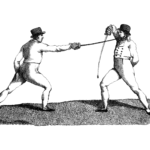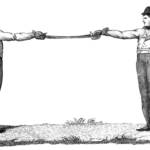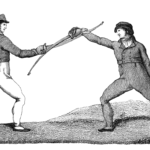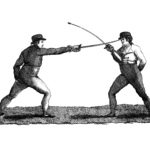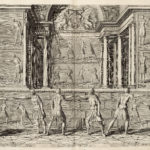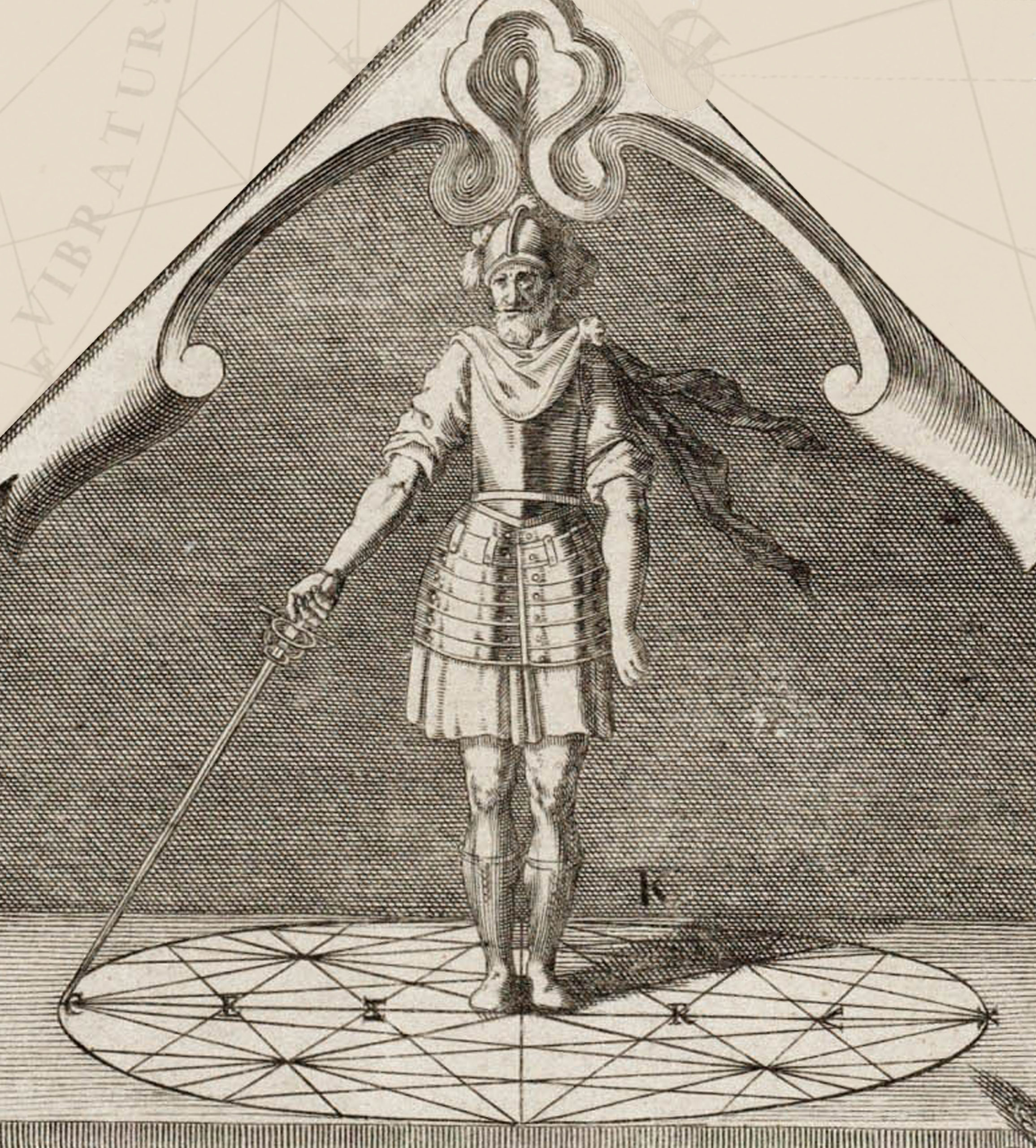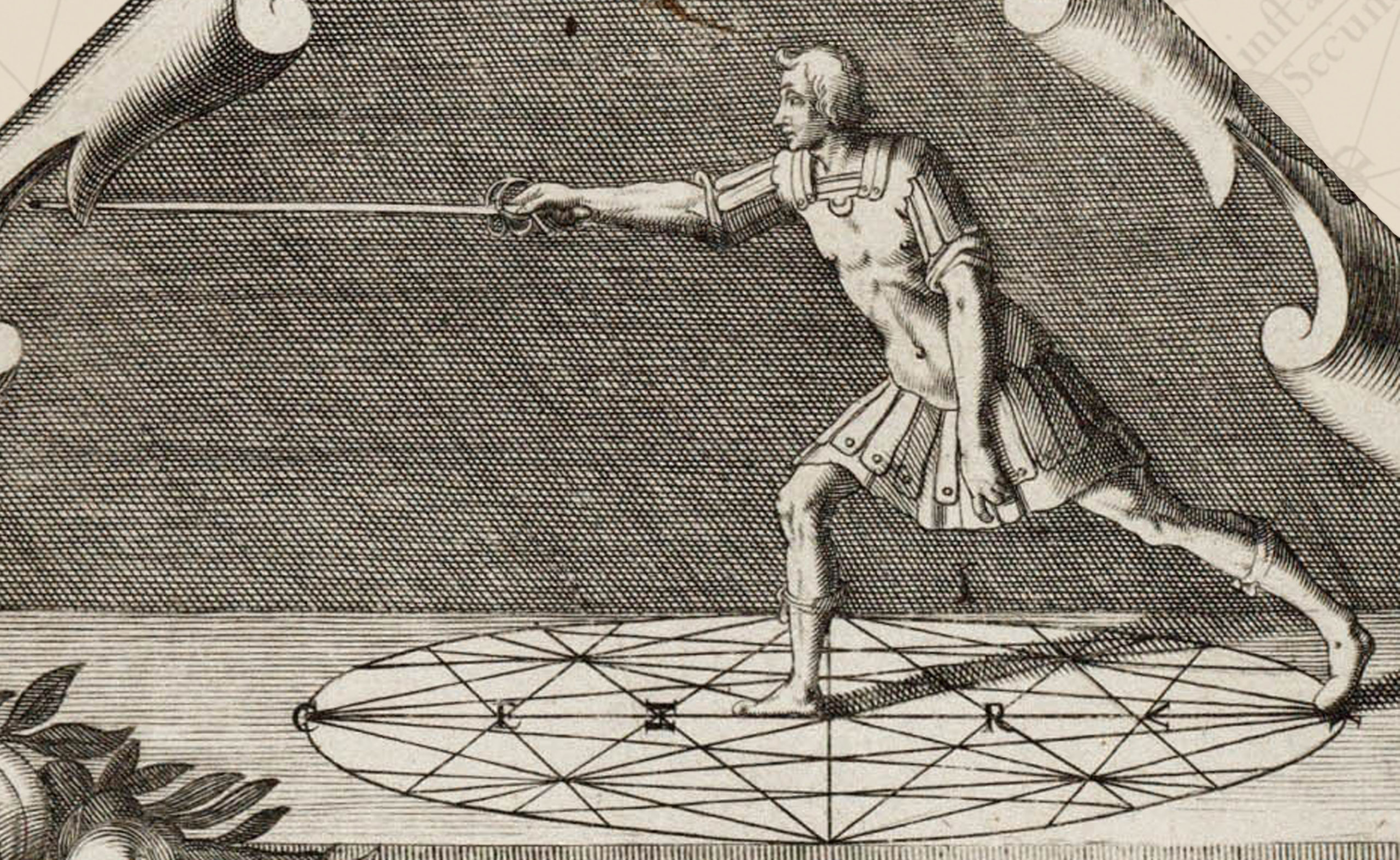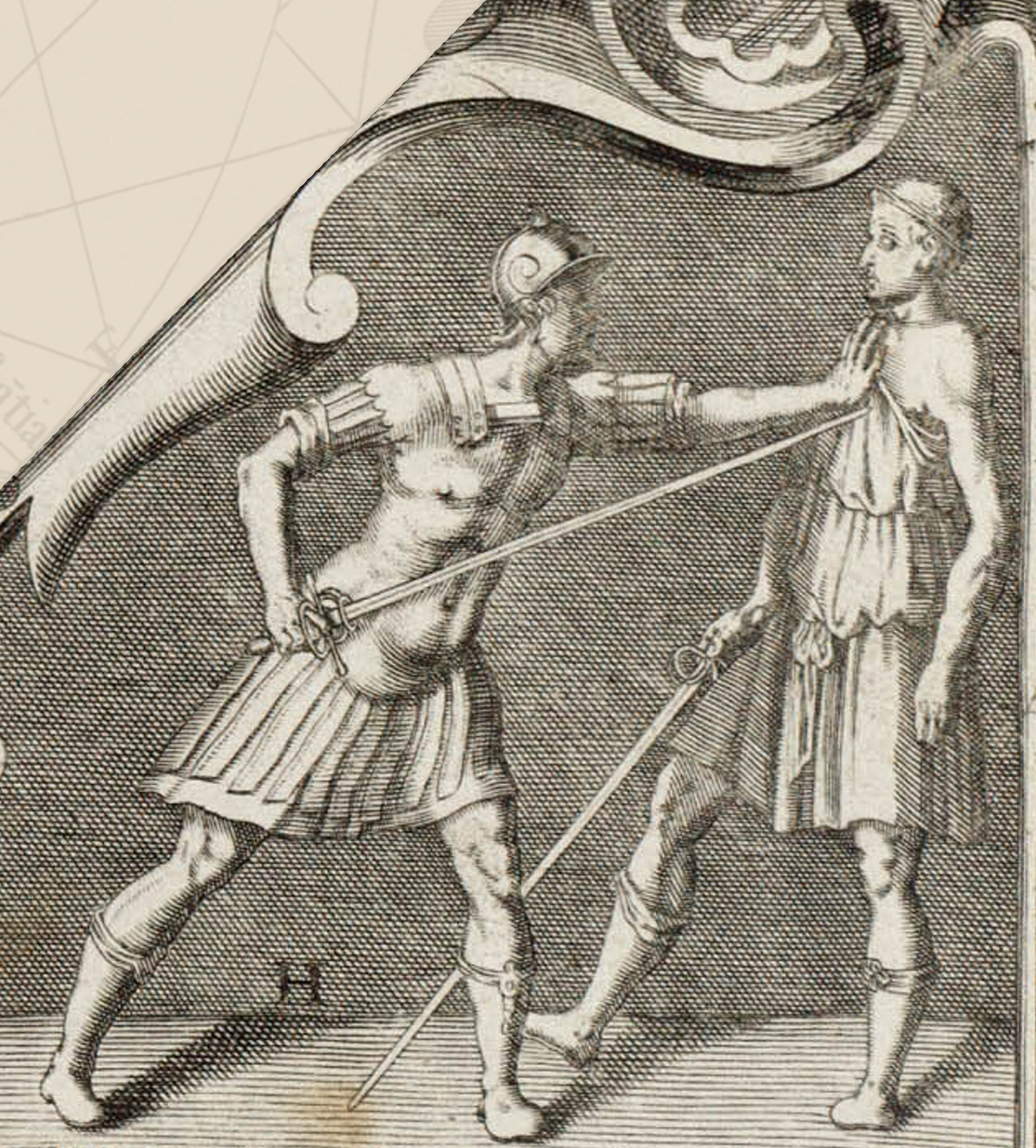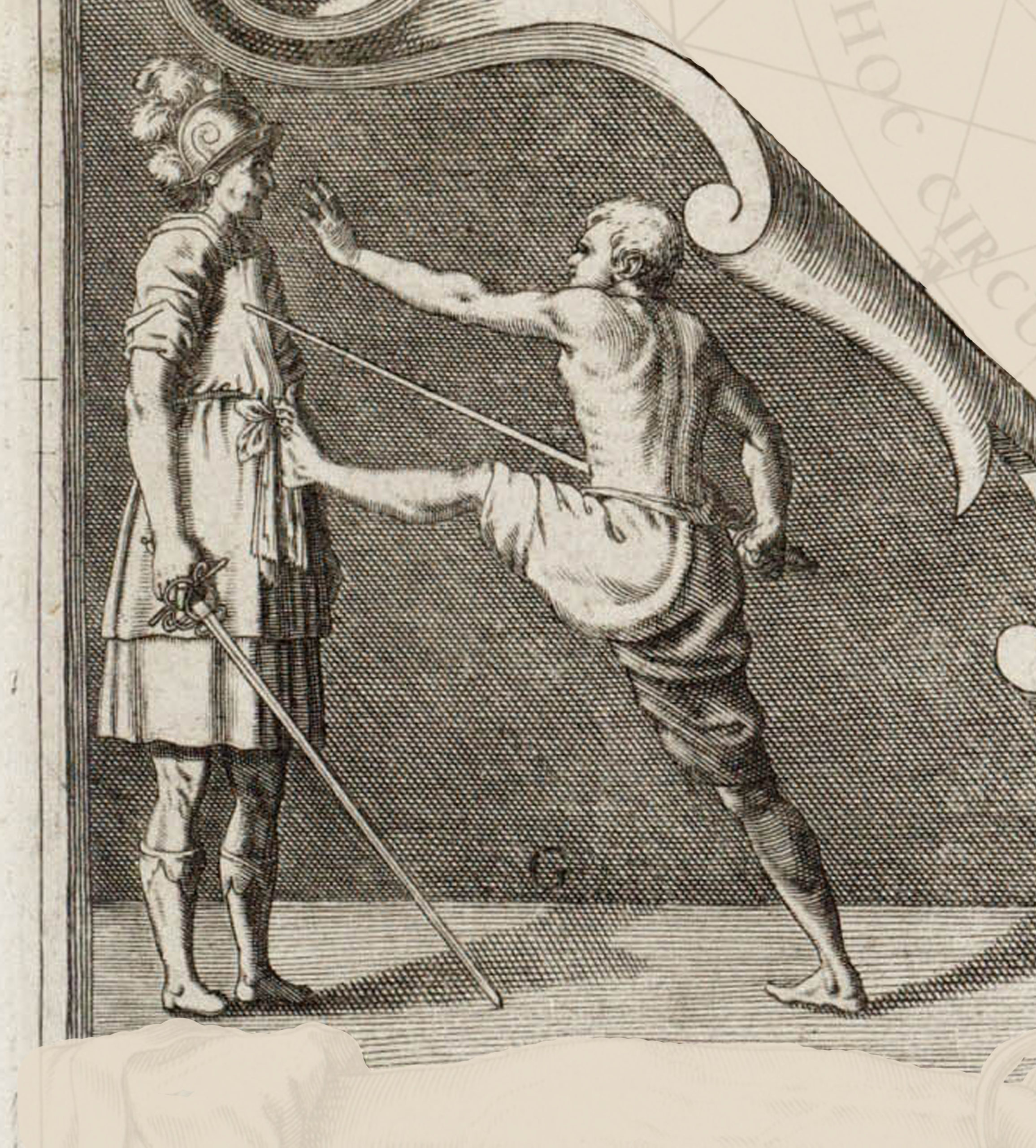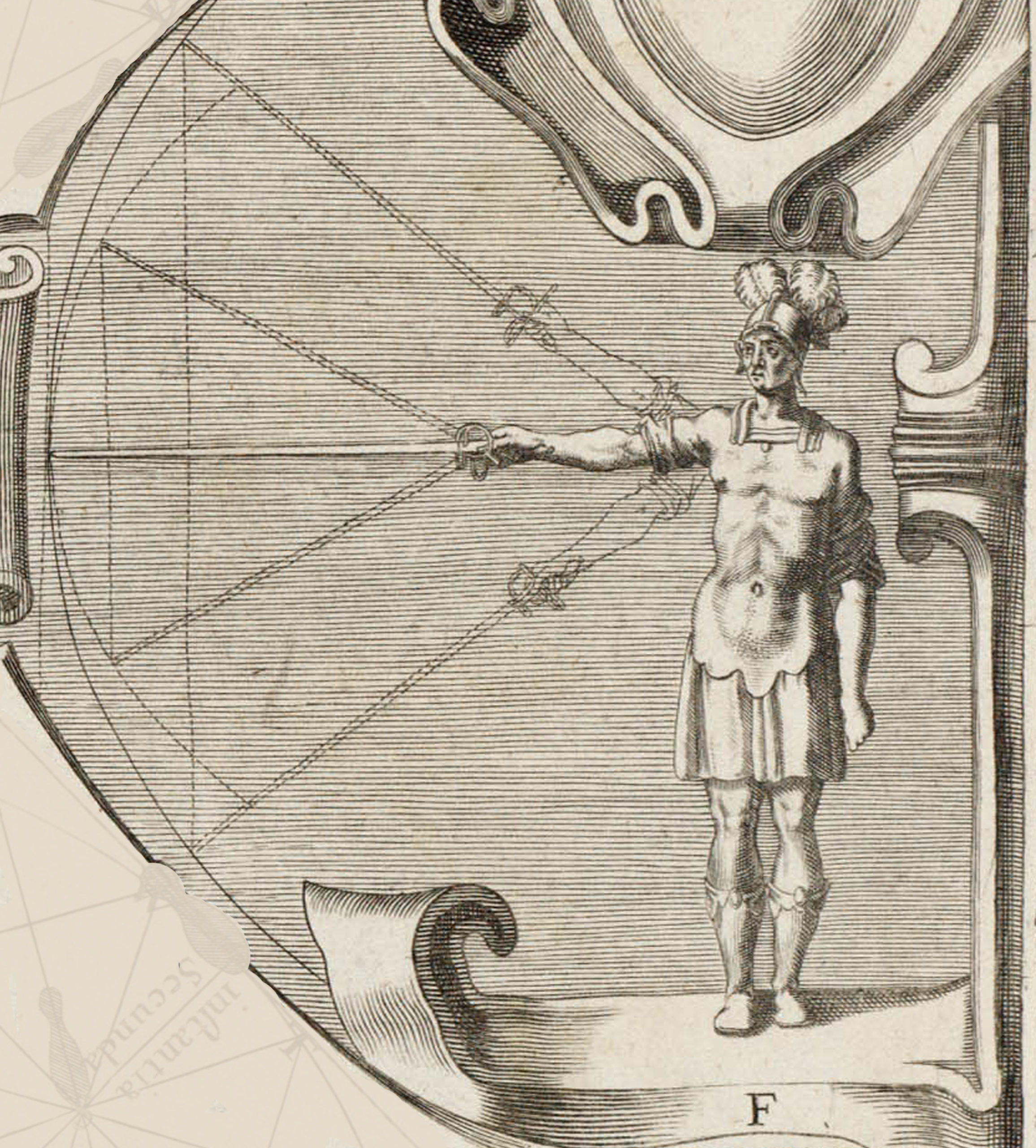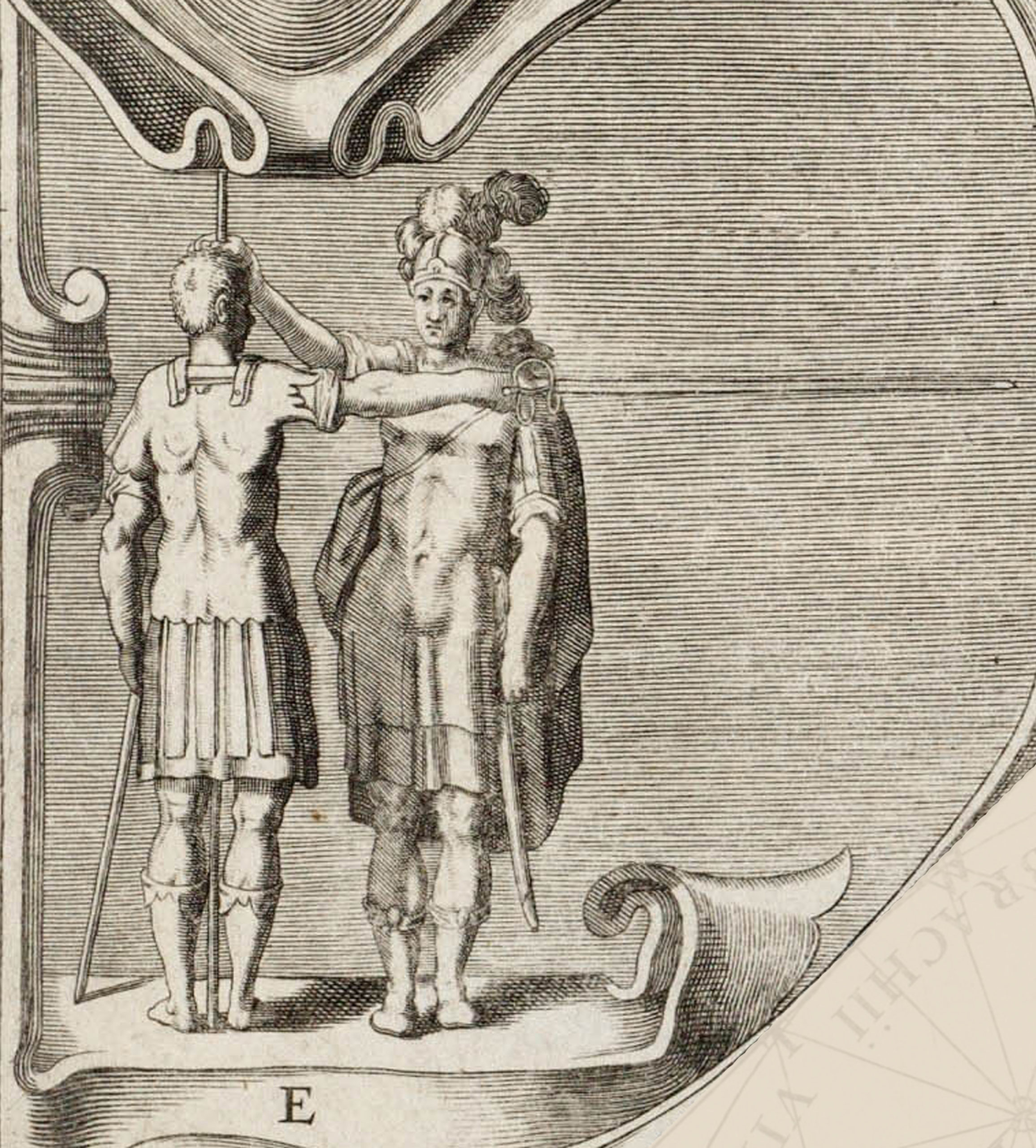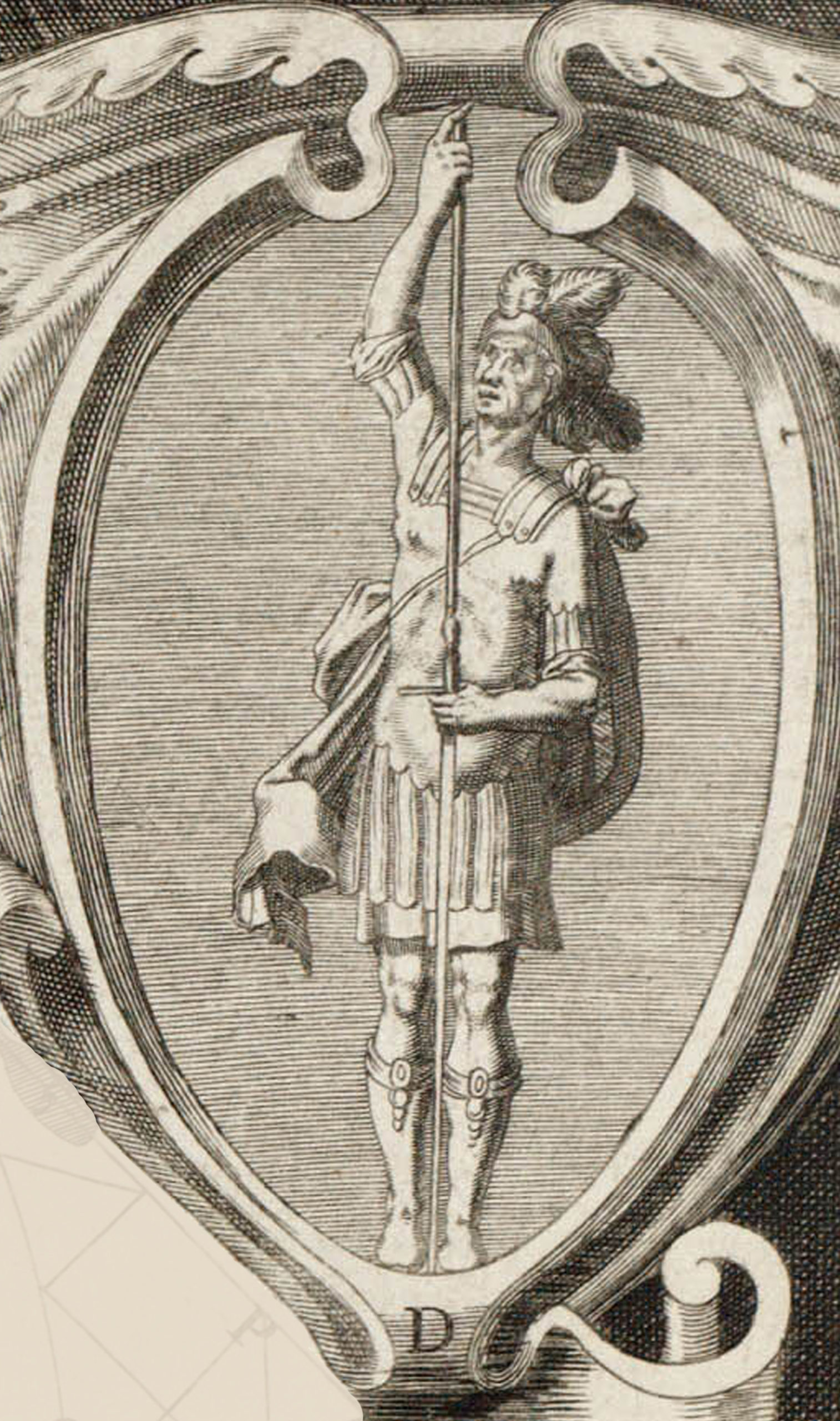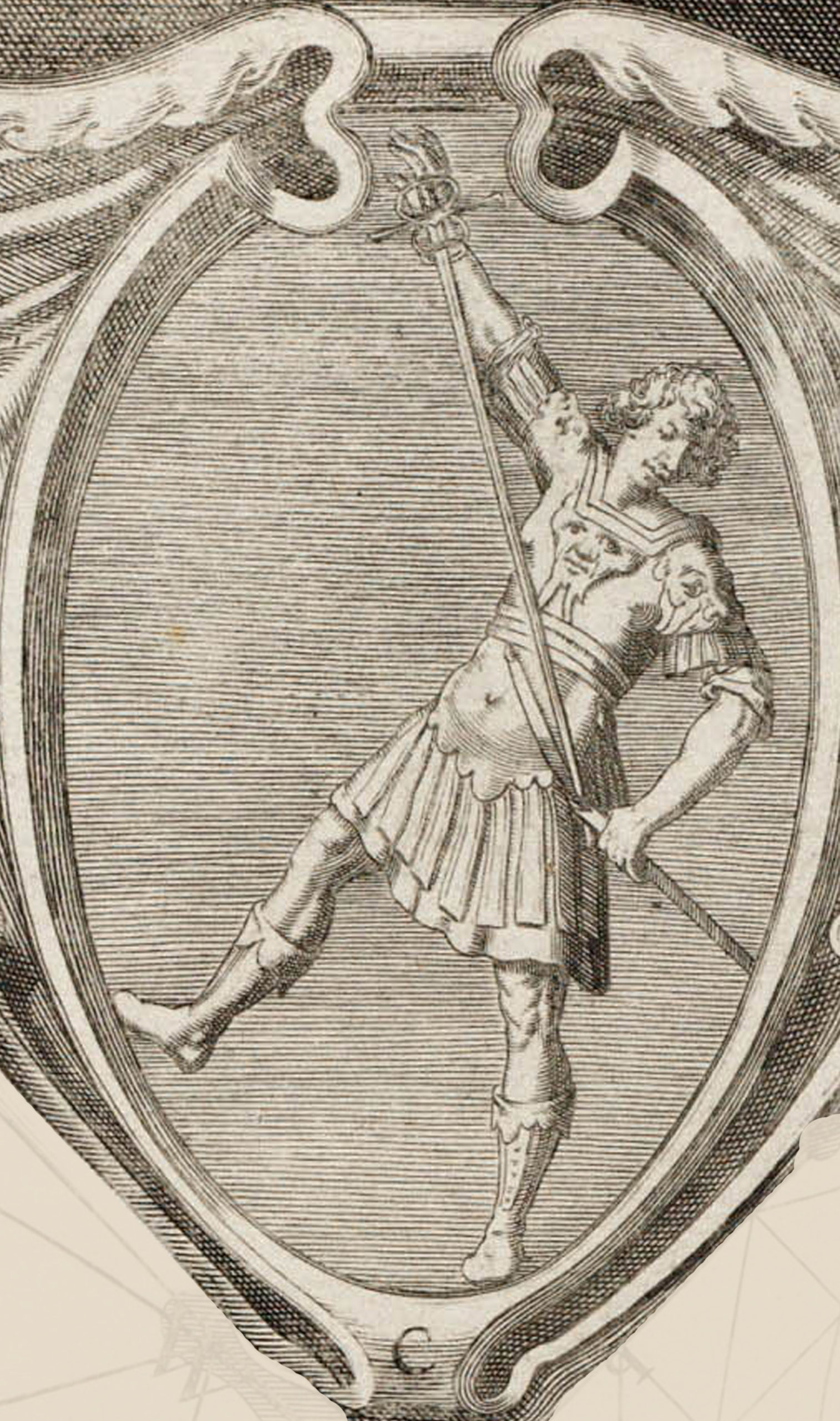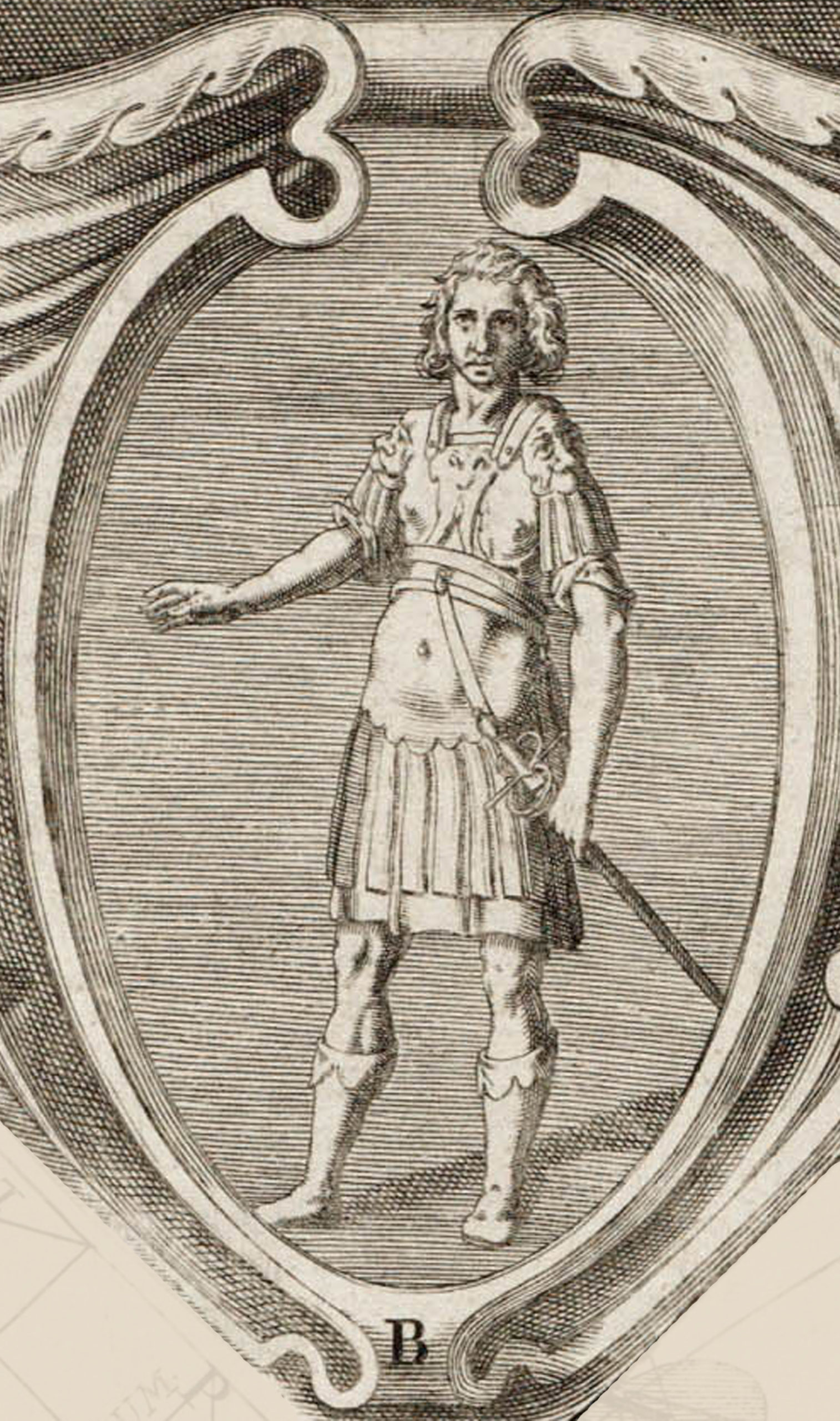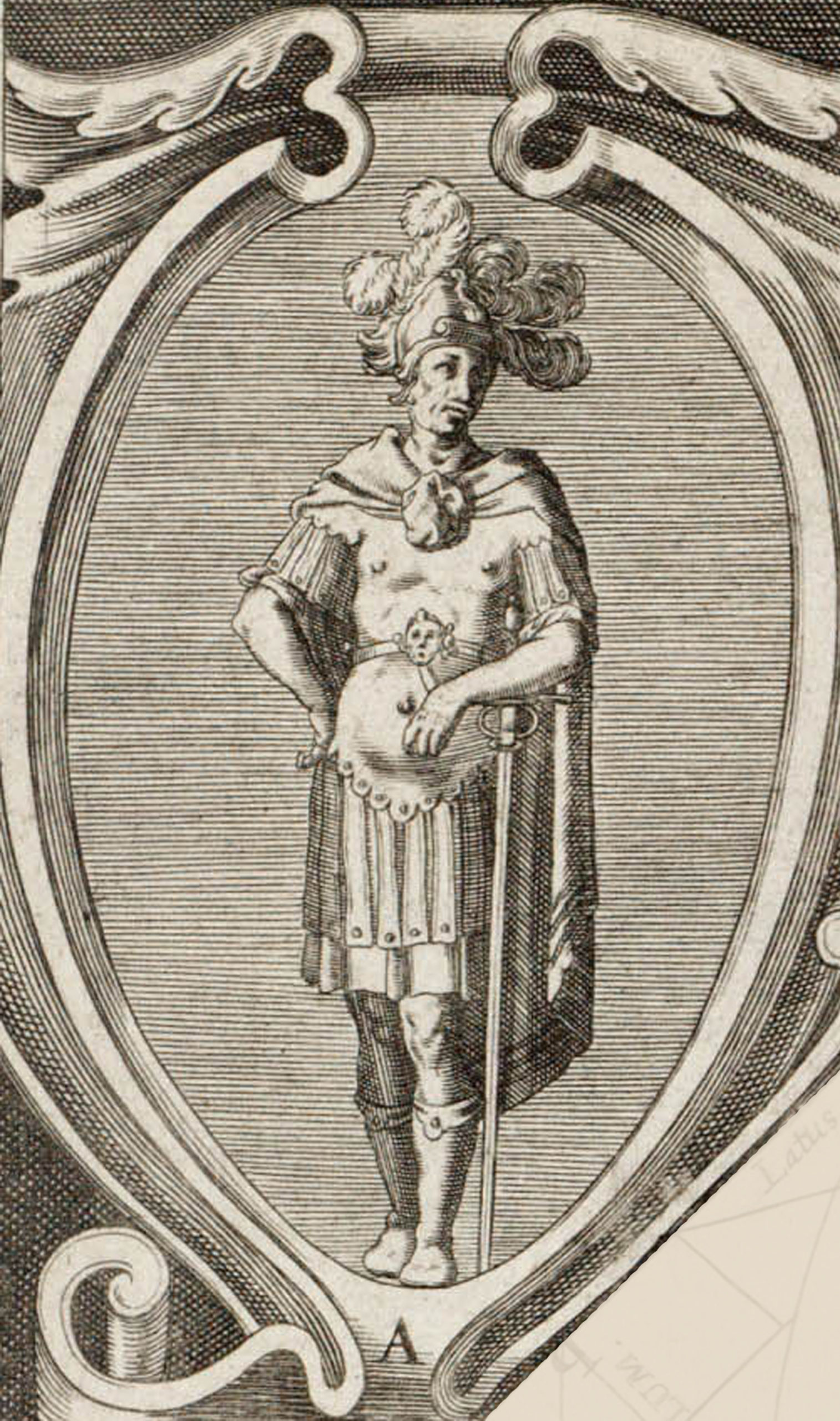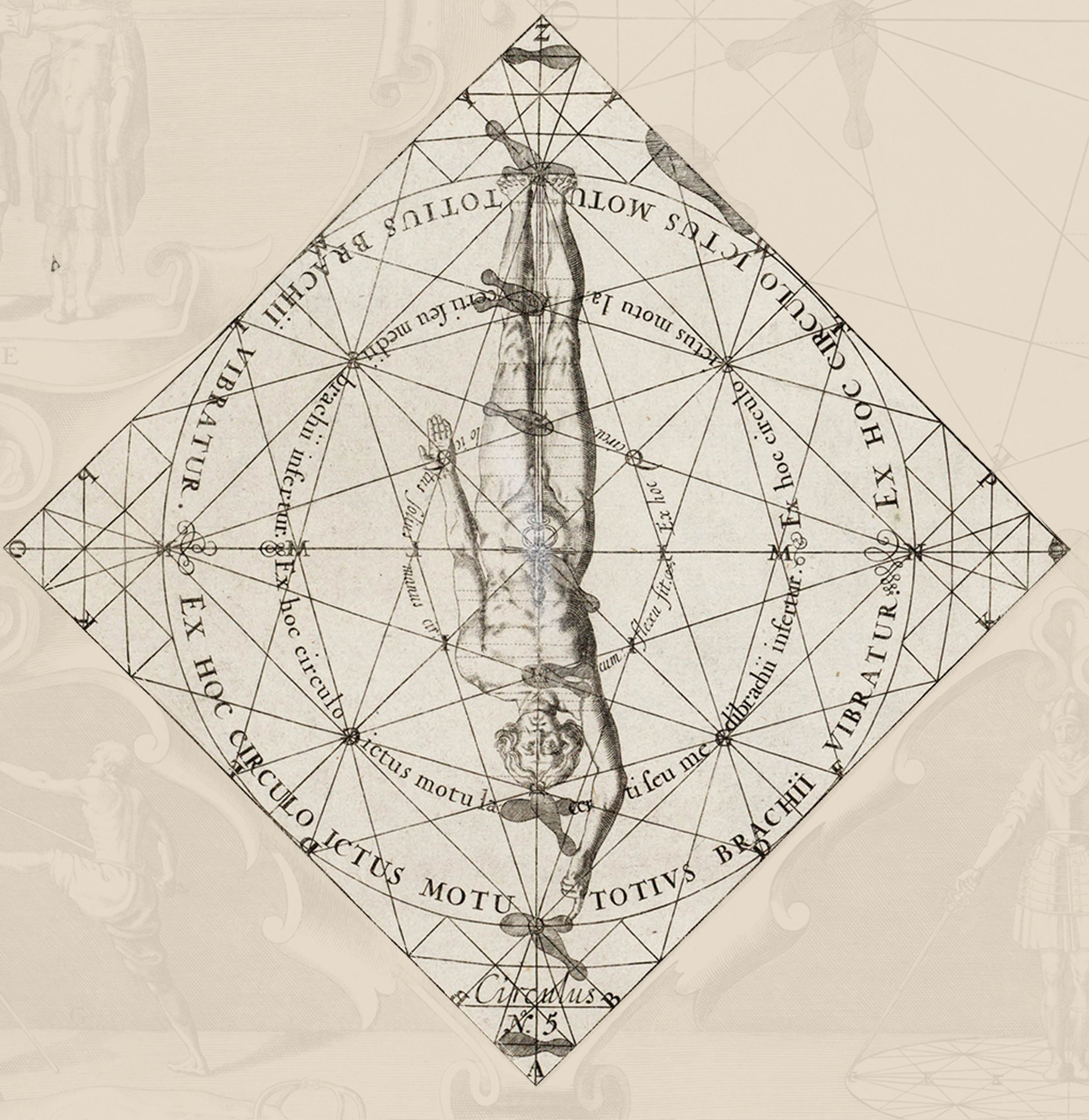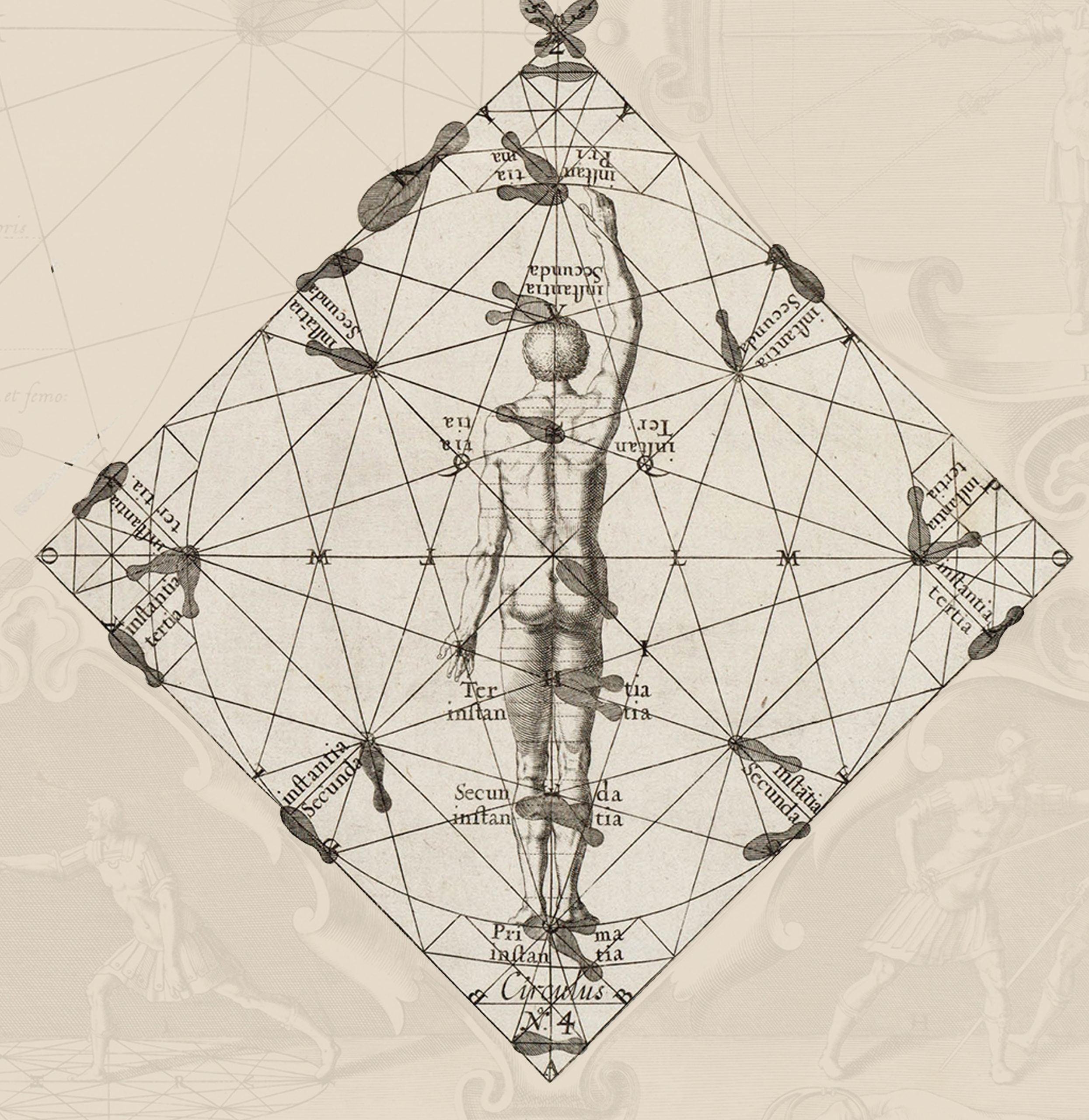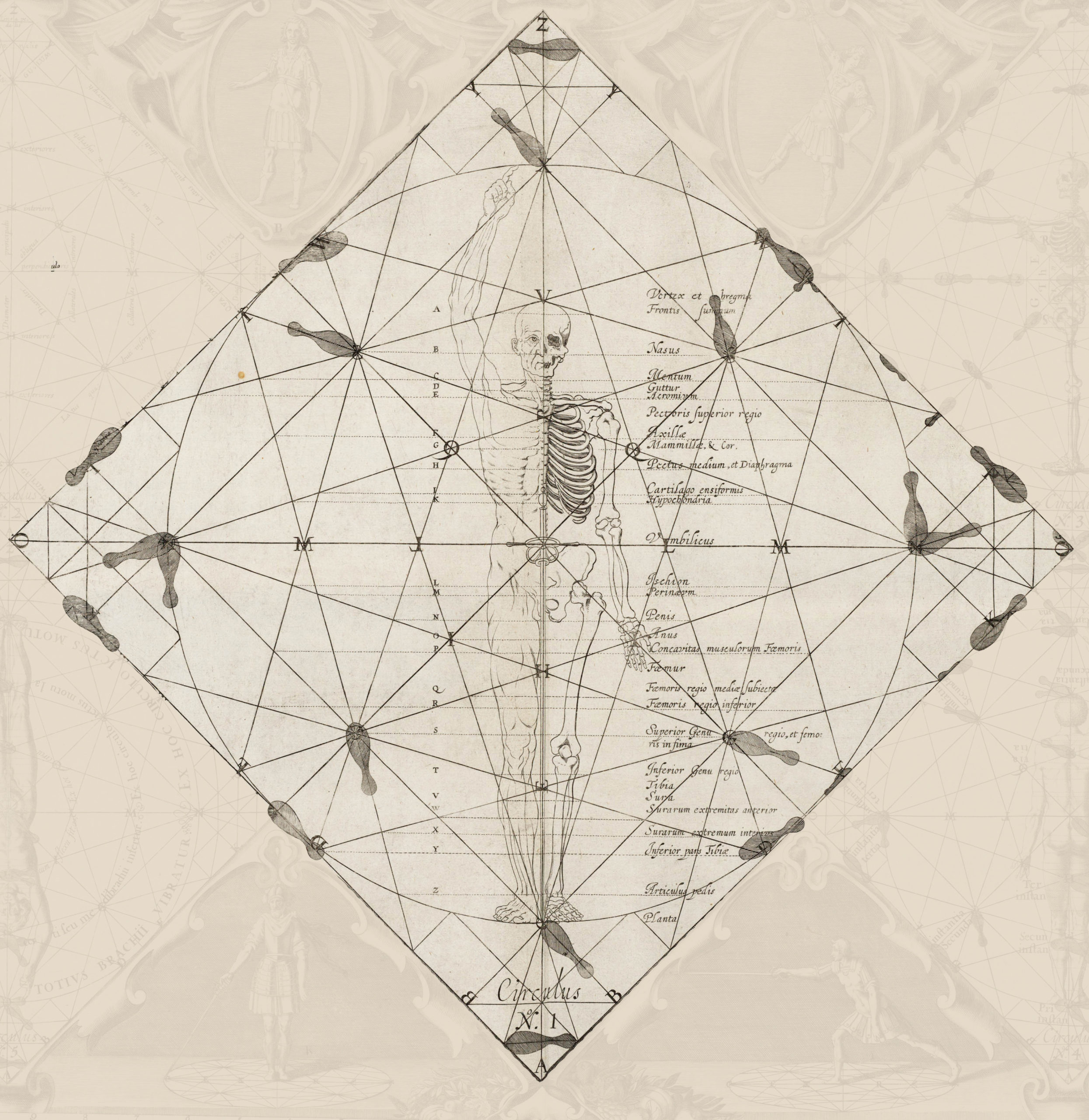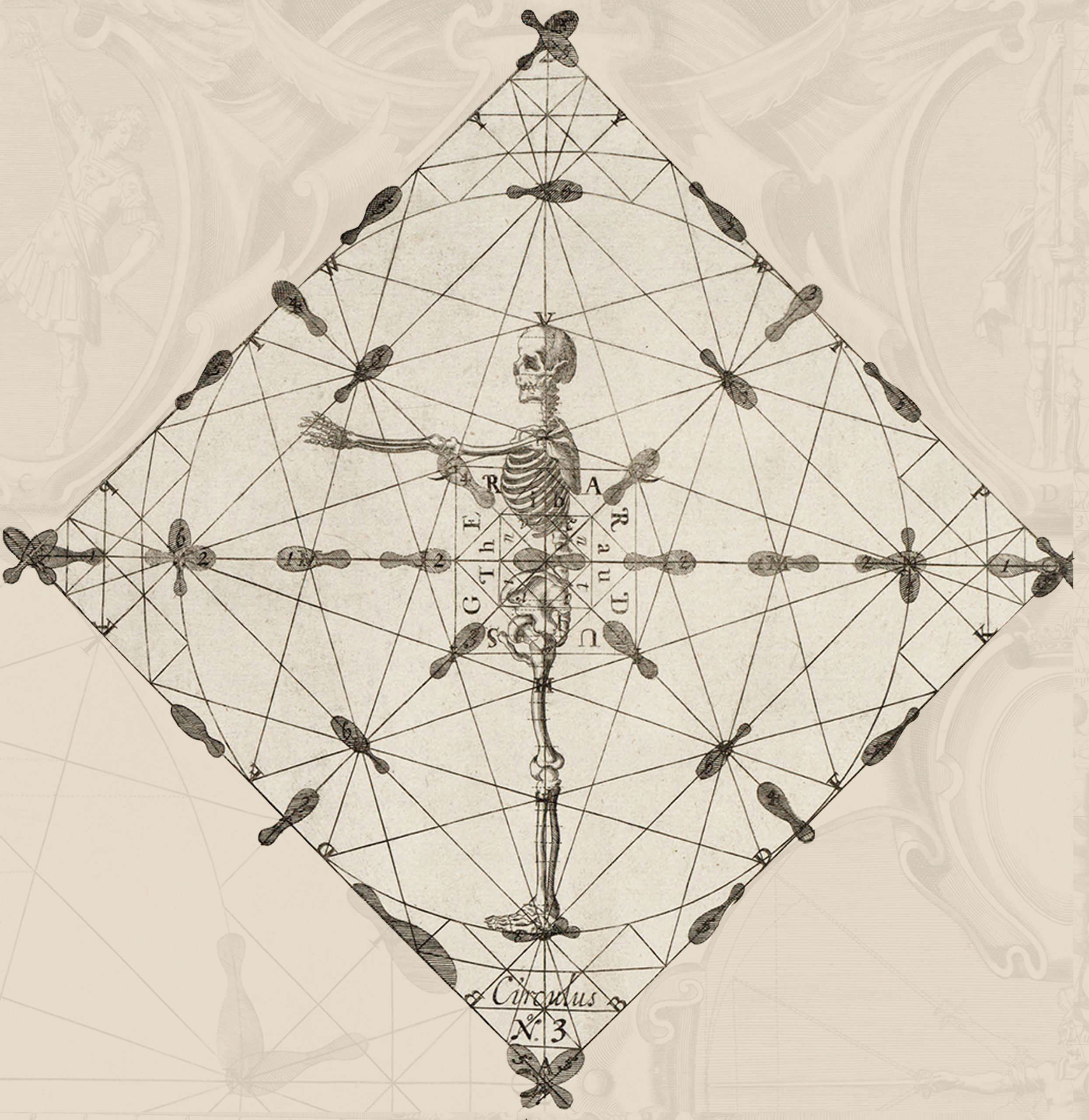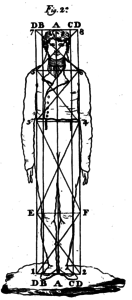Frías categorizes his parries as First Order and Second Order. The First Order parries (Third, Fourth, Fifth, and Sixth) can be taken as guards or used to parry initial attacks, while the Second Order parries are used against redoublements. Third and Fourth, what Frías calls the “superior guards,” primarily protect against thrusts to the upper body and cuts to the head and neck while the “inferior” guards of Fifth and Sixth protect against thrusts and cuts to the lower body. In this case, the words superior and inferior can be used to refer to the position of your blade while in the guard relative to that of your opponent.
When noting the applications for each guard, I have left out instances where the blow being countered is not sufficiently defined to provide useful information. There are many descriptions, for example, to the effect of “suppose you parry the initial blow with a parry of X”. In these cases the type of blow would need to be inferred based on the other documented applications. That just seems a bit too meta. Similarly, I have omitted references where the guard or parry exists simply to provide an initial context for the exercise as these speak more to the openings, which are already addressed, than they do to any specific application of the parry.
Guardia Común / Common Guard
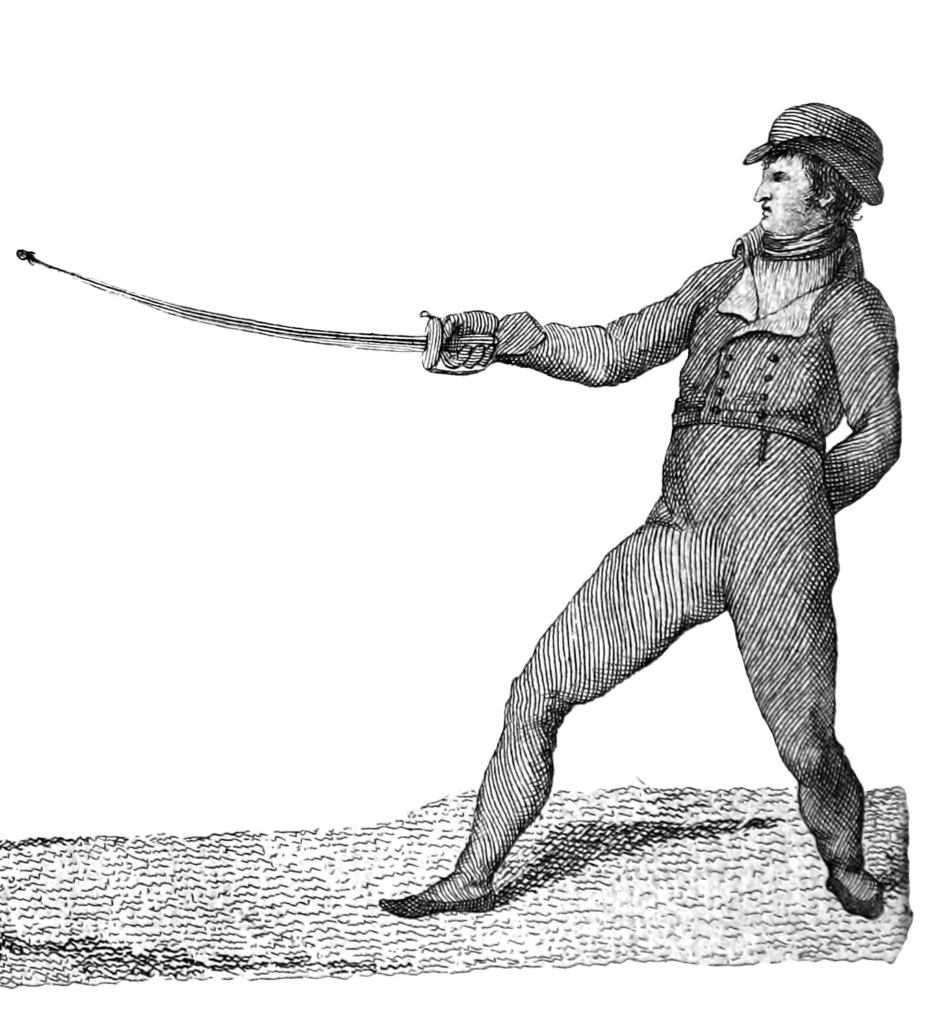
Order: N/A
Description: Right arm slightly bent, guard at waist-height, point at the height of the opponent’s mouth, cutting edge directed downward, left hand held back. See paragraph 52.
Notes: Common Guard is Frías’ starting place for most of the early exercises, possibly because it provides an easily understood neutral position from which to transition to the various guards and strikes. It should not, however, be thought of as a defensive posture so much as a “ready” posture. It is worth mentioning that, while “parada,” “guardia,” and “quite” are used with some interchangeability throughout the book, Frías only ever uses “guardia” in relation to Common Guard, never “parada” or “quite.”
Parada de prima / Parry of First
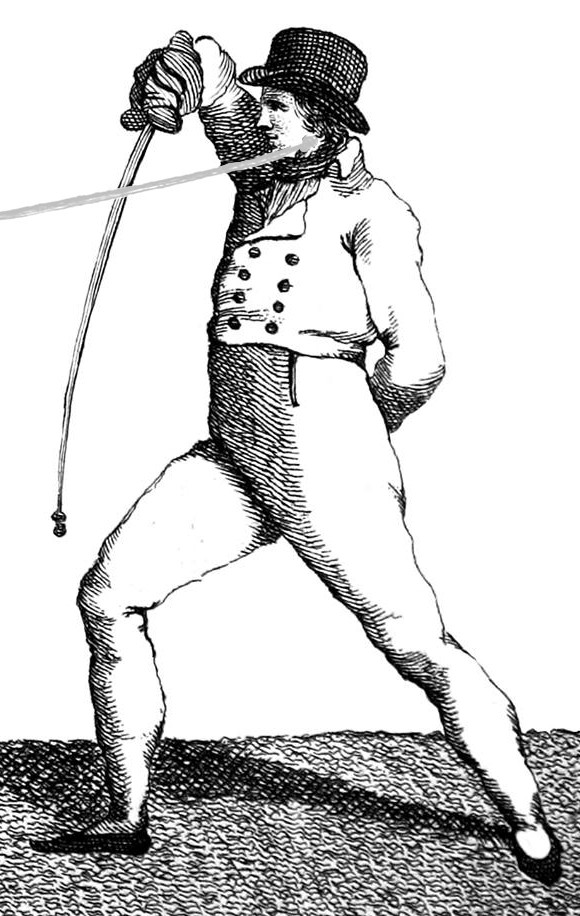
Order: Second
Description: Place your sword hand in front of your left shoulder and above your head so that your blade faces to the left and your palm faces forward. Your point should be directed downward, in front of your right foot, and to the inside. See paragraphs 132, 177, 179, and 99.
Exposure:
- Thrust in Second
- Vertical Reverse to the arm
- Diagonal Reverse to all of the lines on the right side.
Note: paragraph 179 describes the following as the Parry of First to the Head:
… from the parry of fifth, bend the arm raising it at the same time, so that the guard is highest at the Supreme Plane remaining on the Right Vertical, and not very far in front of the body so that the strongest part of the blade covers the entire head and the point inclines toward the enemy, coming to turn away from your own left vertical about two thirds, staying at the height of the Median Plane or higher. In this Removal which is a variation of First, there are uncovered the points stated in paragraph 99 …
Application:
- §132: Parry from Fifth against a redoubled inside thrust to the chest
- §143: Parry from Fourth against a diagonal half cut to the right thigh (recommendation against)
- §151: Parry from a thrust against a half cut to the face
- §174: Parry from Third against a redoubled cut to the flank
- §177: Parry from Fifth against a redoubled thrust of First to the Chest
- §181: Parry from Fifth against a redoubled cut to the left side
- §235: Parry from Fifth against a redoubled half-cut to the neck or face
- §265: Parry from Fifth against a redoubled cut to the left flank
- §278: Parry from a Thrust of First against a thrust to the chest
- §312: Transfer of conclusion from a thrust of Third
- §314: Parry from Fifth in preparation for a conclusion against a thrust of First
- §337: Transferring the conclusion on the thrust of First
- §362: Parry in preparation for a blow of the hand against a thrust of First
- §398: Parry against a thrust of First
- §399: Parry against a thrust of Third
- §401: Parry against a thrust of Third
Parada de segunda / Parry of Second
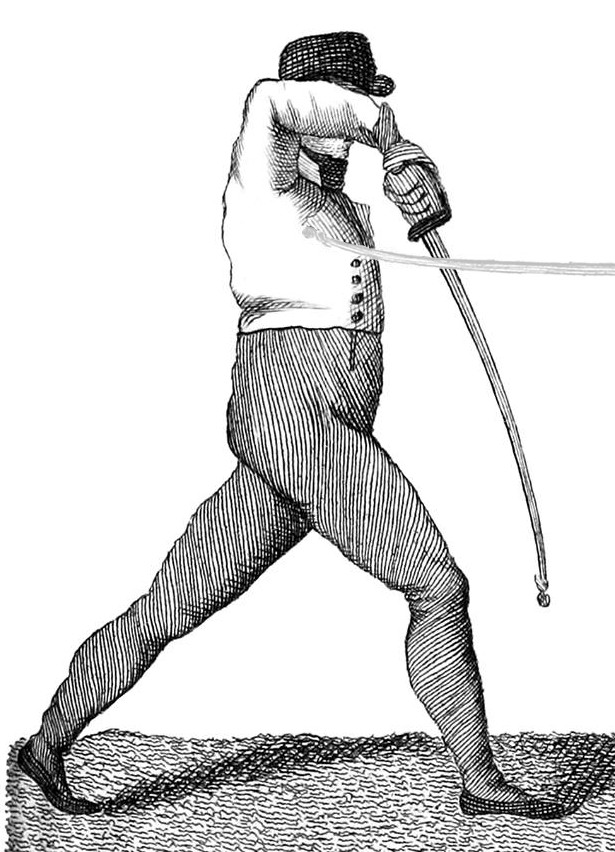
Order: Second
Description: With your hand in Third, lower the point so that your sword is near vertical, the edge facing outward, the point a little further outside than your hand, with your hand in front of your shoulder and your elbow high. See paragraphs 133 and 183.
Exposure below the guard:
- Thrust in first
- All the diagonal cuts to the left side
If you do an open parry or by leaving the diameter:
- Vertical to the arm
- Vertical to the shoulder
- Vertical to the head
Application:
- §133: Parry from Sixth against a free thrust of Second to the flank
- §167: Parry from Third against a half reverse to the knee as an inferior alternative to simply withdrawing the leg.
- §169: Parry from Third against a redoubled half reverse to the face or neck
- §183: Parry from Sixth against a redoubled thrust of Second
- §185: Parry from Sixth against a redoubled diagonal half reverse
- §239: Parry from Fourth against a redoubled diagonal reverse to the body
- §246: Parry from Fourth against a half reverse
- §250: Parry from First against a redoubled thrust of Second
- §259: Parry from Sixth against a redoubled thrust of Second
- §260: Parry from Sixth against a redoubled diagonal reverse to the flank
- §277: Parry from Common against a Thrust of Second
- §308: Transfer of conclusion on Low Fourth
- §339: Alternative conclusion on the thrust of Second
- §341: Transfer of conclusion on the thrust of Second
- §363: Parry from Sixth in preparation for a blow of the hand against a thrust of Second or a diagonal Reverse to the side
Parada de tercia / Parry of Third
Order: First
Description: Hand held palm down in the median plain, elbow advanced from the flank, point at the height of the ear, directed to the adversaries right vertical. See paragraphs 81, 82, and 96.
Hand held palm down in the median plain, elbow advanced from the flank, point at the height of the ear, directed to the adversaries right vertical. See paragraphs 81, 82, and 96.
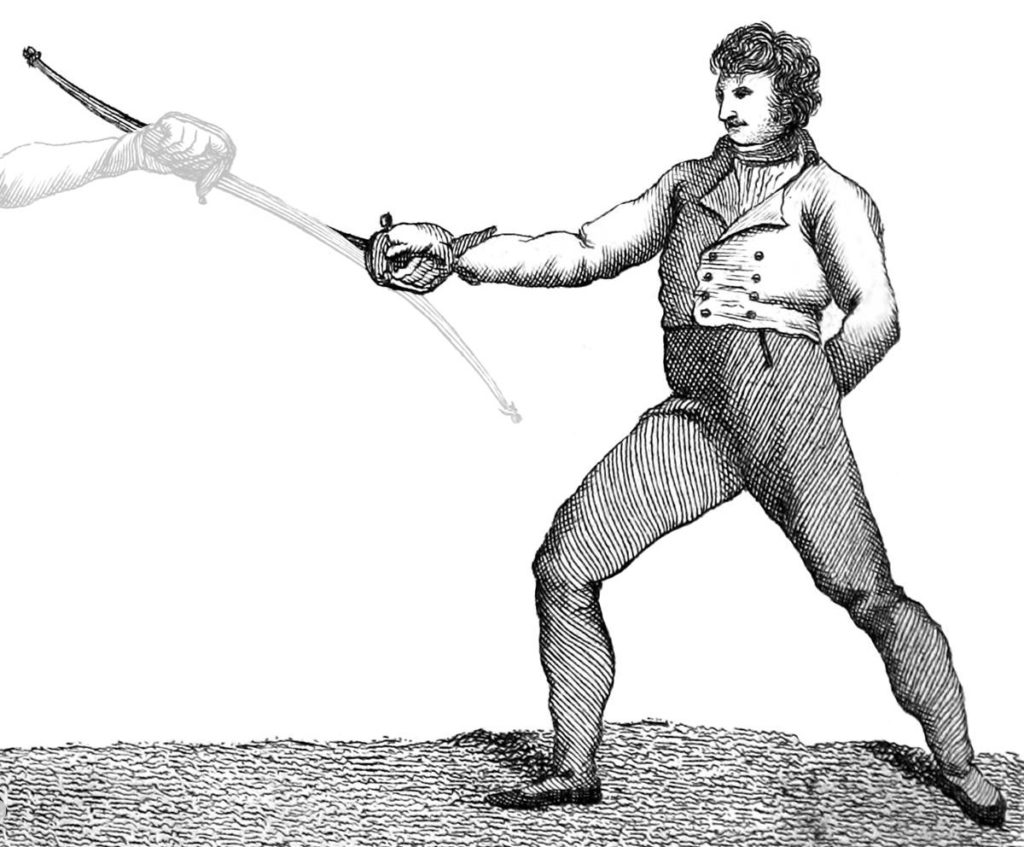
Exposure below the guard:
- Blow to the wrist or below the arm with the Counter-Edge
- Thrust in second between the weapons
- Diagonal Reverse from the right hip to the left shoulder
- Reverse to the knee
Exposure by the point:
- Half-Reverse to the face
- Vertical Cut to the head
- Diagonal to any of the lines on the left side
Parada de tercia baxa / Parry of Low Third
Order: Second
Description: Modify the parry of Third by drawing your sword elbow back to your flank keeping your forearm more or less parallel to the ground and allowing the point to open to the outside. See paragraphs 129 and 137. This guard opposes that of Sixth. See paragraph 112.
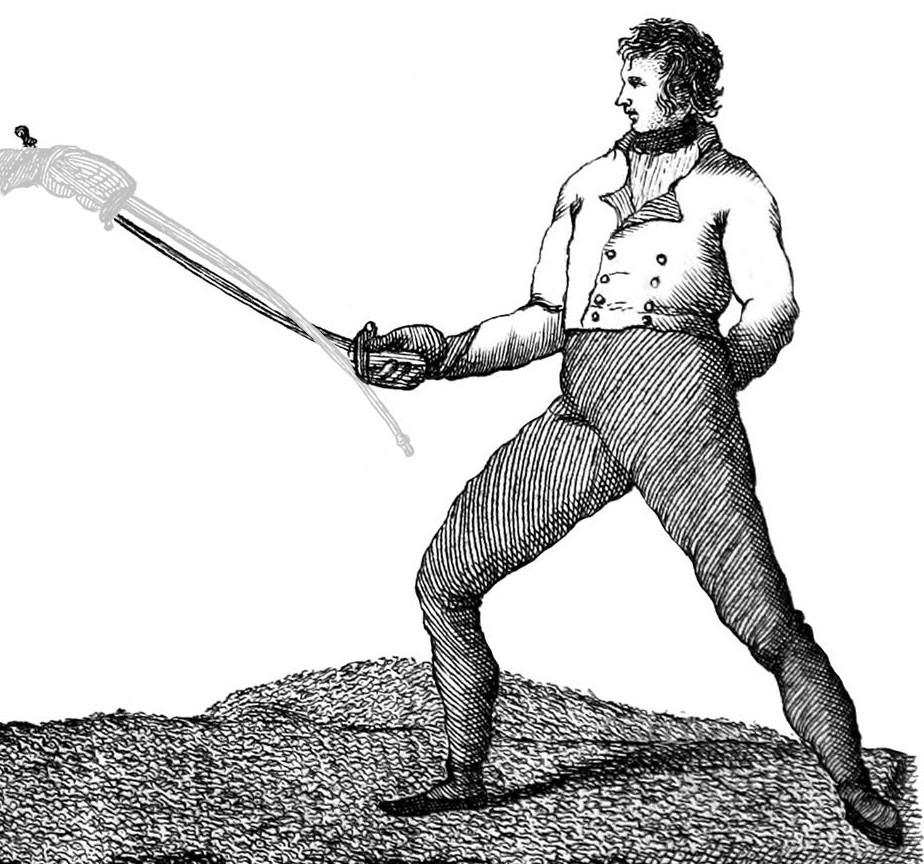
Exposure below the guard:
- Half-Reverse
- Vertical Cut
- All of the diagonals to the left side
Exposure by the point:
- Thrust in Second between the weapons
- Thrust in Fourth
- Reverse to the thigh
- Diagonal from the right flank to the opposite shoulder
Parada de tercia alta / Parry of High Third
Order: Second
Description: From Third, raise your sword hand to the height of your shoulder, keeping your point forward and inside the right vertical. See paragraphs 131 and 147.
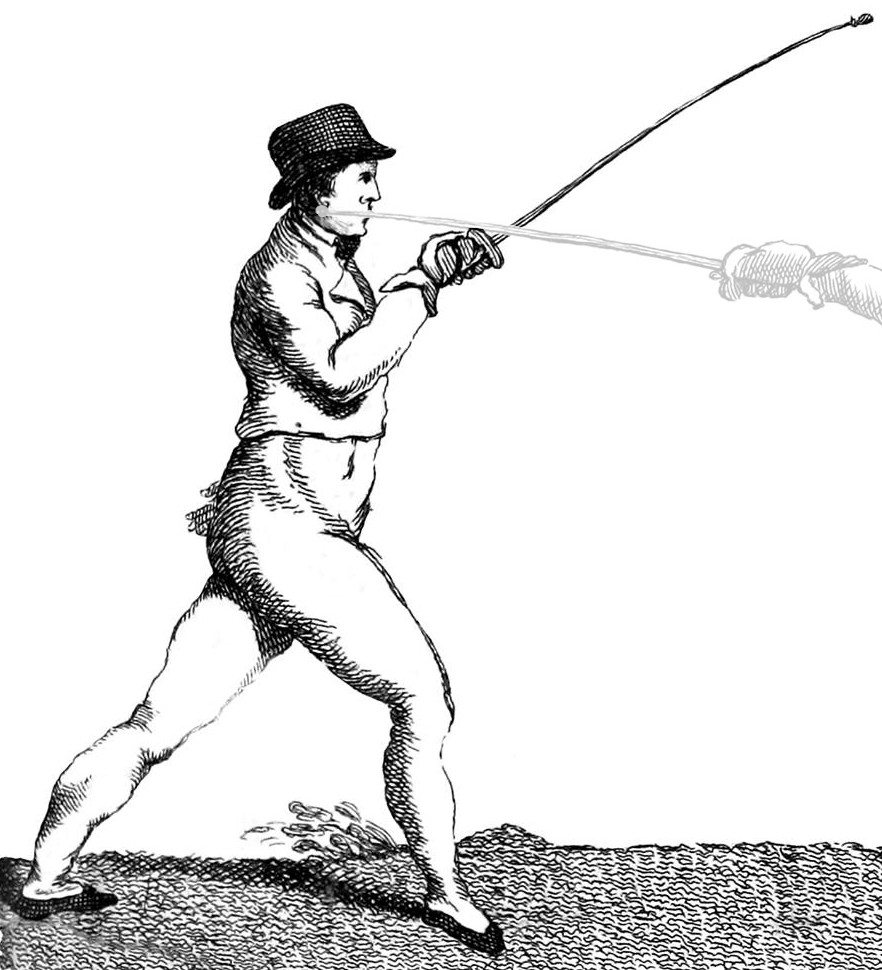
Exposure below the guard:
- Half-reverse to the arm
- Half-reverse to the thigh
- Half-reverse to the belly
- Diagonal or horizontal cut from haunch to shoulder
- Thrust of Second
Exposure by the point:
- Vertical to the face
- Diagonal to the face
- Vertical or diagonal to any point on the left vertical
Note: There is a slight variation on this guard which Frías calls Parada de Tercia Recojida or collected parry of high third. In this variation, the elbow is drawn more tightly into the flank and the torso is rolled to square.
Parada de quarta / Parry of Fourth
Order: First
Description: Hand held palm up in the median plain, point at the height of the ear, directed to the adversaries left vertical. See paragraph 80.
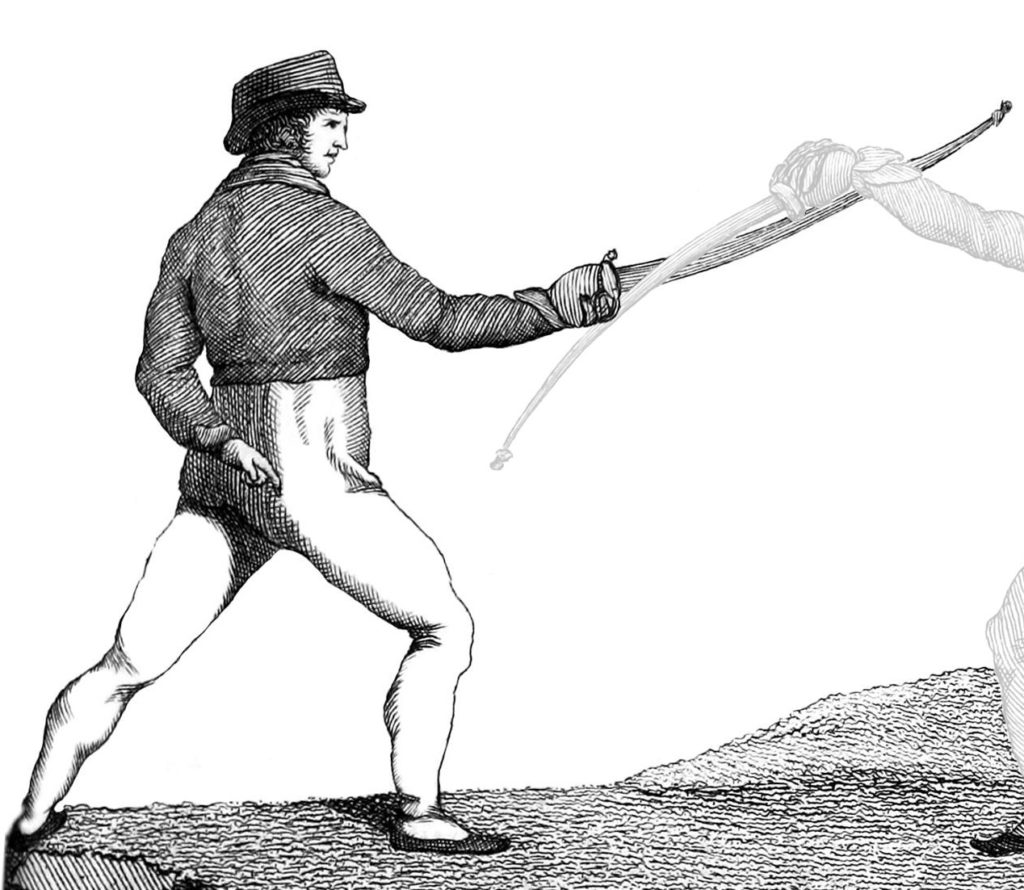
Exposure below the guard:
- Thrust in Third
- Counter-Edge Blow to the Wrist
- Edge Blow to the Thigh
- Half-Reverse
- Vertical Cut to the Arm
- Vertical Cut to the Head
- Diagonal Reverse to the Head
Exposure by the point:
- Half-Cut
- Vertical Reverse to the Head
- Diagonal Reverse to the Head
- Diagonal Reverse to anywhere along the lines of the right side.
Parada de quarta baxa / Parry of Low Fourth
Order: Second
Description: From Fourth, withdraw the hand until your sword elbow is against your sword-side flank. See paragraph 128.
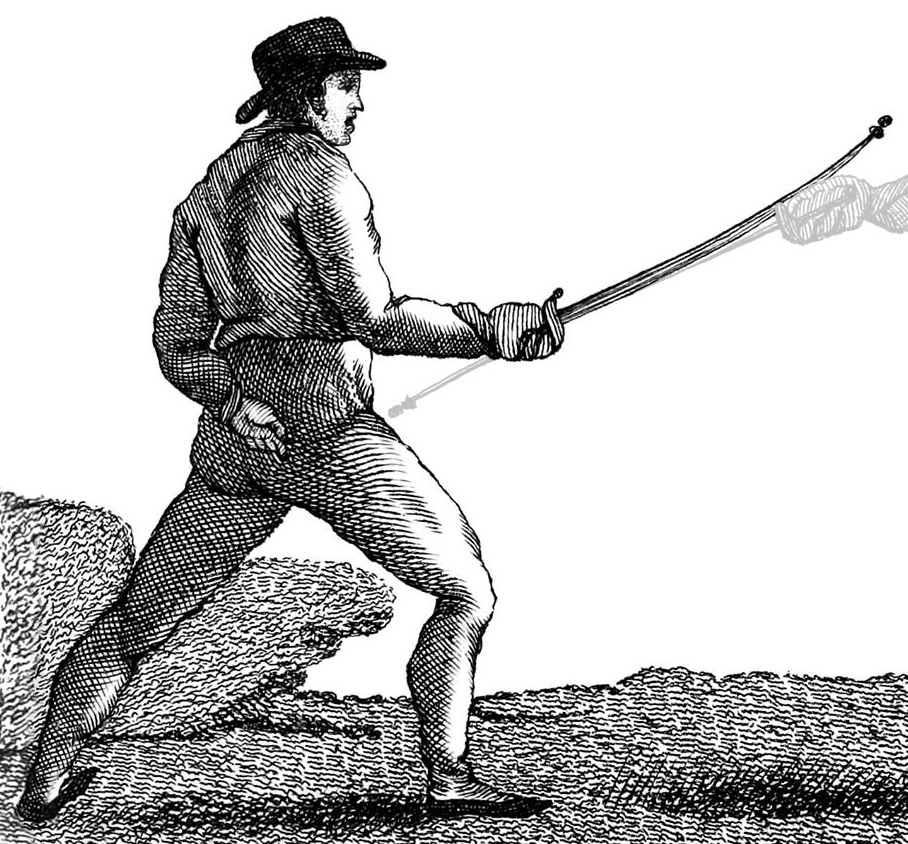
Exposure below the guard:
- Thrust in Third
- Counter-Edge Blow to the Wrist
- Edge Blow to the Thigh
- Half-Reverse
- Vertical Cut to the Arm
- Vertical Cut to the Head
- Diagonal Reverse to the Head
Exposure by the point:
- Half-Cut
- Vertical Reverse to the Head
- Diagonal Reverse to the Head
- Diagonal Reverse to anywhere along the lines of the right side.
Parada de quarta baxa tendido el brazo / Extended Arm Parry of Low Fourth
Order: Second
Description: From low Fourth, extend the sword hand forward until the arm is straight. See paragraphs 139 and 140.
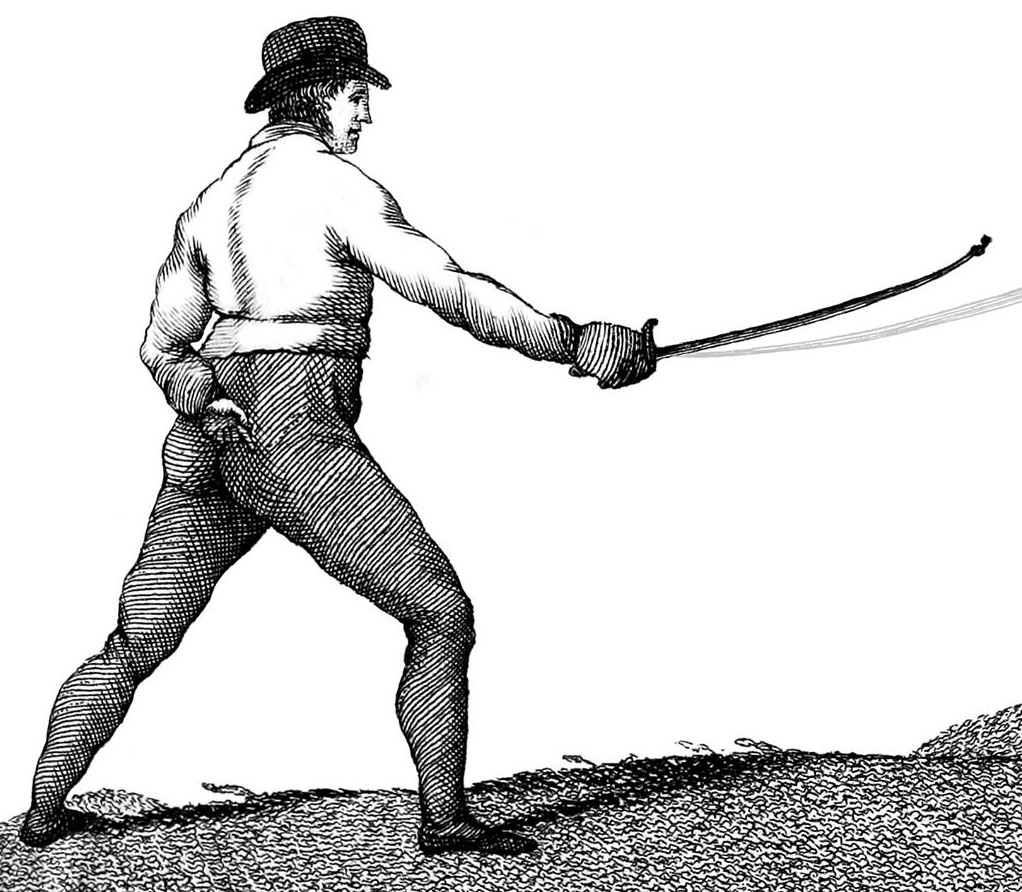
Exposure below the guard:
- Thrust in Third
- Counter-Edge Blow to the Wrist
- Edge Blow to the Thigh
- Half-Reverse
- Vertical Cut to the Arm
- Vertical Cut to the Head
- Diagonal Reverse to the Head
Exposure by the point:
- Half-Cut
- Vertical Reverse to the Head
- Diagonal Reverse to the Head
- Diagonal Reverse to anywhere along the lines of the right side.
Parada de quarta alta / Parry of High Fourth
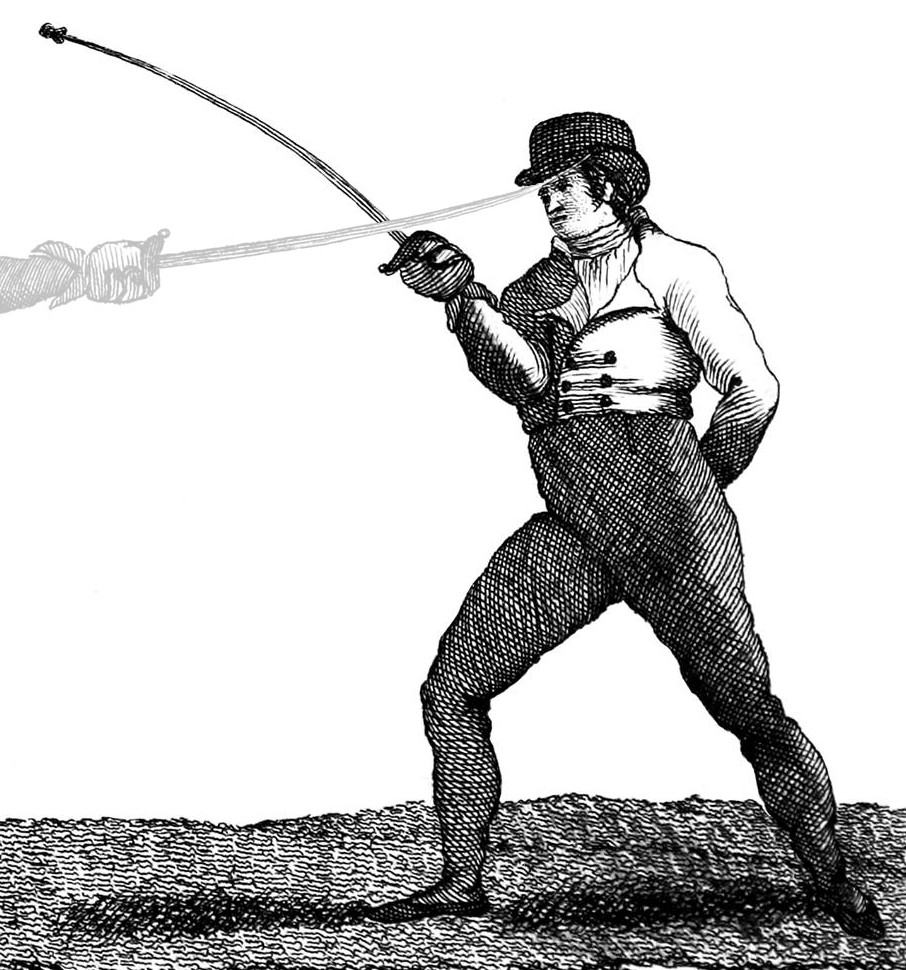
Order: Second
Description: Hand in fourth in the left vertical at shoulder height. The blade should follow the left diagonal of the opponent’s face, with the point higher than your head, the hand one third of the way from your face and the point two thirds forward. See paragraph 80.
Exposure below the guard:
- Half-Cut to the arm
- Half-Cut to the stomach with the counter-edge
- Diagonal cut to the leg
- Thrust of Second below the hand
Note: The book identifies this as corresponding to image Letter D of Lamina 10, Figure 19. I have instead shown Image Letter C. I believe the book notation to be in error as Letter D shows an attack whereas Letter C matches the written description of the parry.
Exposure by the point:
- Diagonal reverse to the face
- Diagonal reverse to any of the lines of the right side
Parada de quinta / Parry of Fifth
Order: First
Description: Hand palm down, guard at eye level, point at waist height and advanced toward the enemy’s left vertical. See paragraphs 84 and 102. This guard is opposes the guard of Fourth. See paragraph 110.
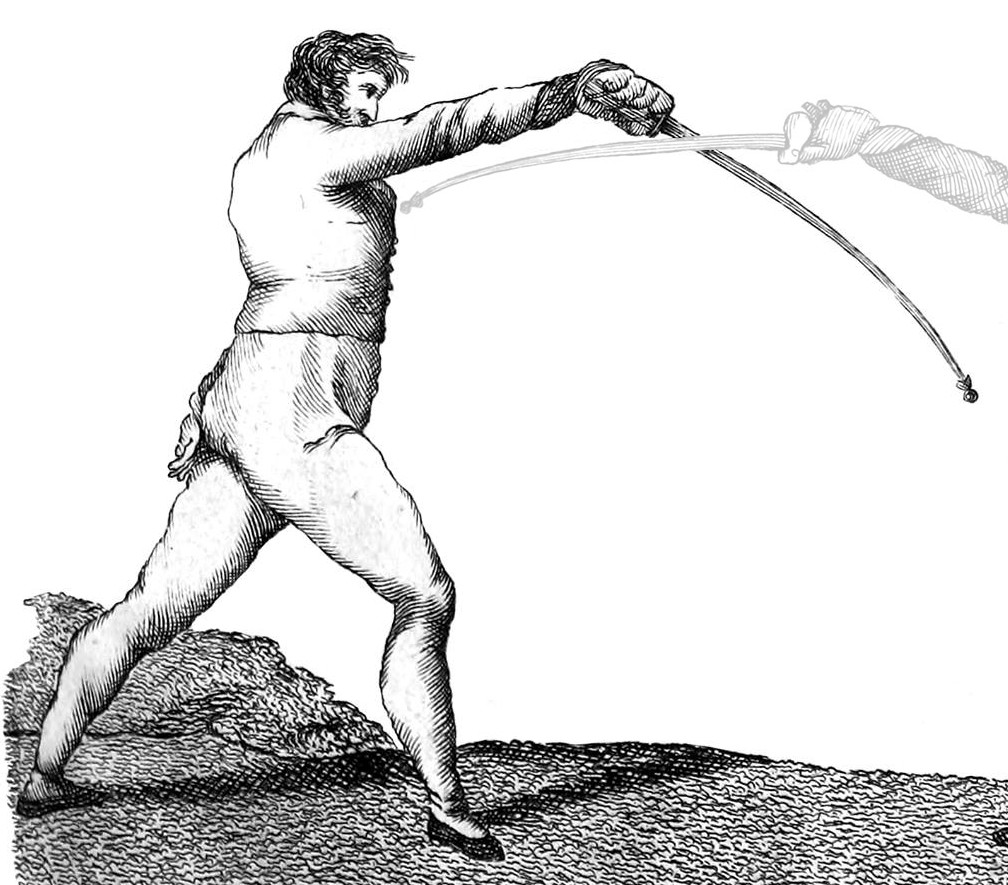
Exposure below the guard:
- Thrust in first
- All the diagonal cuts to the left side
If you do an open parry or by leaving the diameter:
- Vertical to the arm
- Vertical to the shoulder
- Vertical to the head
Note: These are the same openings that are uncovered in the parry of Second.
Note 2: a parry identified as Low Fifth is described in paragraphs 160 and 161 as follows:
160. Remove this blow by making the point of the sabre form a portion of a circle, starting from the point where you are forming the Third, by passing it over the arm of the contrary and in front of his face, going down by his right vertial, ending in front of the collateral on this side, to the height of the middle of his thigh raising for this the hand to your superior plane, and staying on the line of the Right Vertical, take the full position of Third with your arm somewhat bent, and the body the motion of square, making these movements united and prompt and you will have effected the Remove that is called Low Fifth (Lam. 9, Let. D.), being a variation of the Fifth and Second. This blow is well removed with Low Fourth (§. 139), but then there is no Removal that is not without limitations and, as my intent is not to lose sight of the greater security, I prefer the Low Fifth mindful of its generality, for when blows are thrown from below the guard, in the Parry of Third, be it high, low, or regular, they will be perfectly removed with the parry stated.
161. In this Remval are uncovered the points noted in Fifth Regular (§. 102).
Application:
- §100: Parry of recovery following a thrust of Second
- §101: Parry from Sixth against a thrust of Second
- §110: Counter-guard in opposition to the guard of Fourth
- §115: Transport from Fourth
- §118: Transport to Fourth
- §160: Parry of Low Fifth from Third against a counter-edge blow to the arm
- §163: Parry from a thrust of Third against thrust of Second between the weapons
- §165: Parry from Third against a diagonal reverse cut along the line from the right hip to the left shoulder
- §175: Parry from Sixth against a thrust of Second
- §228: Parry from Third against a counter-edge blow to the arm
- §234: Parry of low Fifth from high Third against a redoubled thrust of Second
- §238: Parry of low Fifth from high Third against a horizontal half reverse
- §256: Parry from high Third against a thrust of Second
- §261: Parry from Sixth against a thrust of Second
- §277: Change of guard in preparation for a thrust of Second
- §297: Transport from Fourth to Fifth in preparation for a thrust of Second
- §338: Parry from Sixth against a thrust of Second
- §339: Parry of low Fifth against a thrust of Second
- §394: Parry from Fourth against a carrying thrust of Second
- §402: Change of guard in preparation for a thrust of Second or Third
- §408: Parry of low Fifth against an unsheathing cut
Parada de sesta / Parry of Sixth
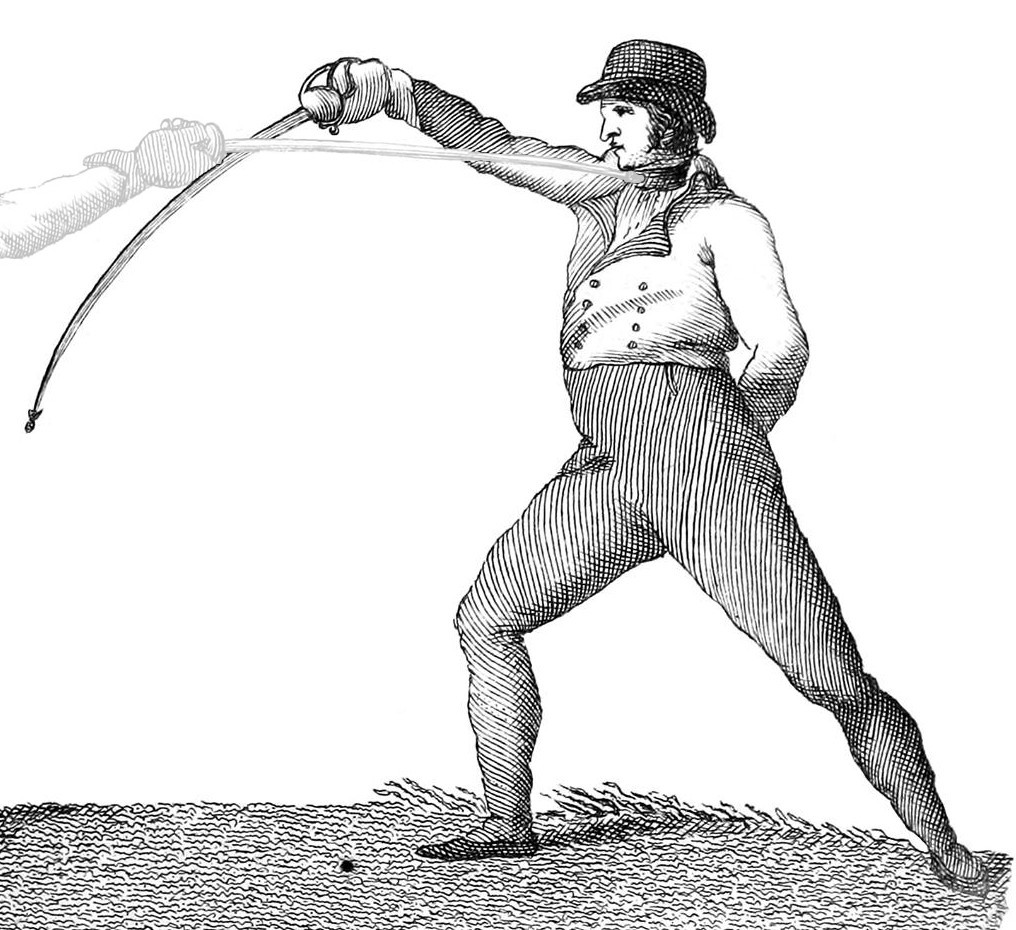
Order: First
Description: Hand at eye level in front of the left shoulder, edge up and to the inside, point low and outside of the opponent’s right vertical. See Paragraph 83. This guard opposes that of Third. See paragraph 111.
Application:
- §97: Parry from Fifth against a thrust of Fourth
- §98: Parry from Fifth against a thrust of Fourth
- §182: Parry from Fifth against a thrust of First
- §254: Parry from Fifth against a thrust of First
- §335: Parry from Fifth against a thrust of First
- §386: Parry against a thrust of First

